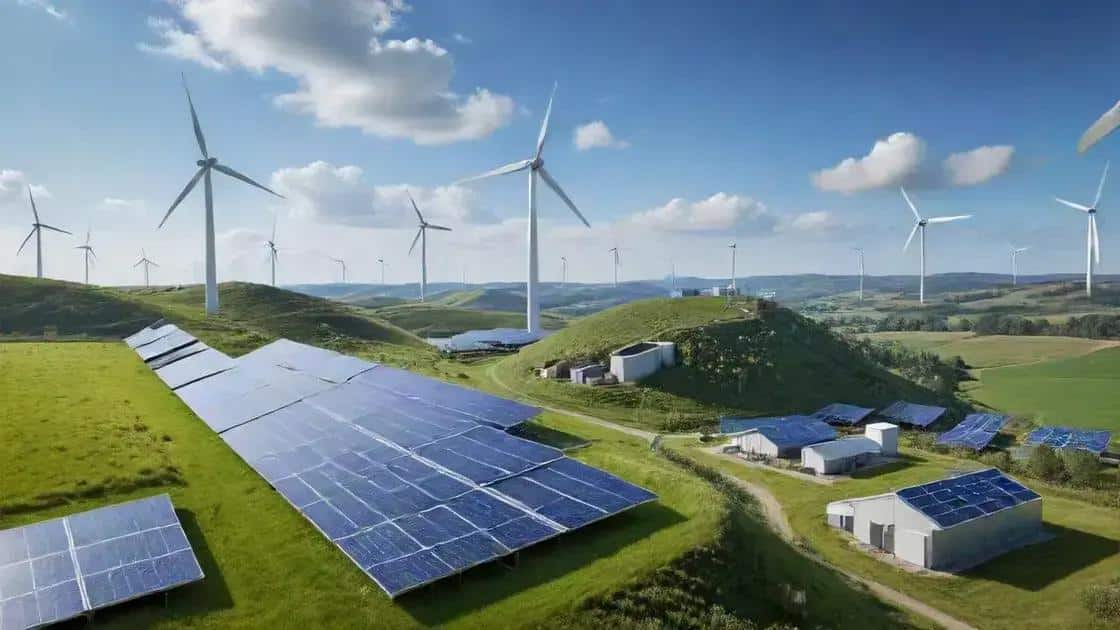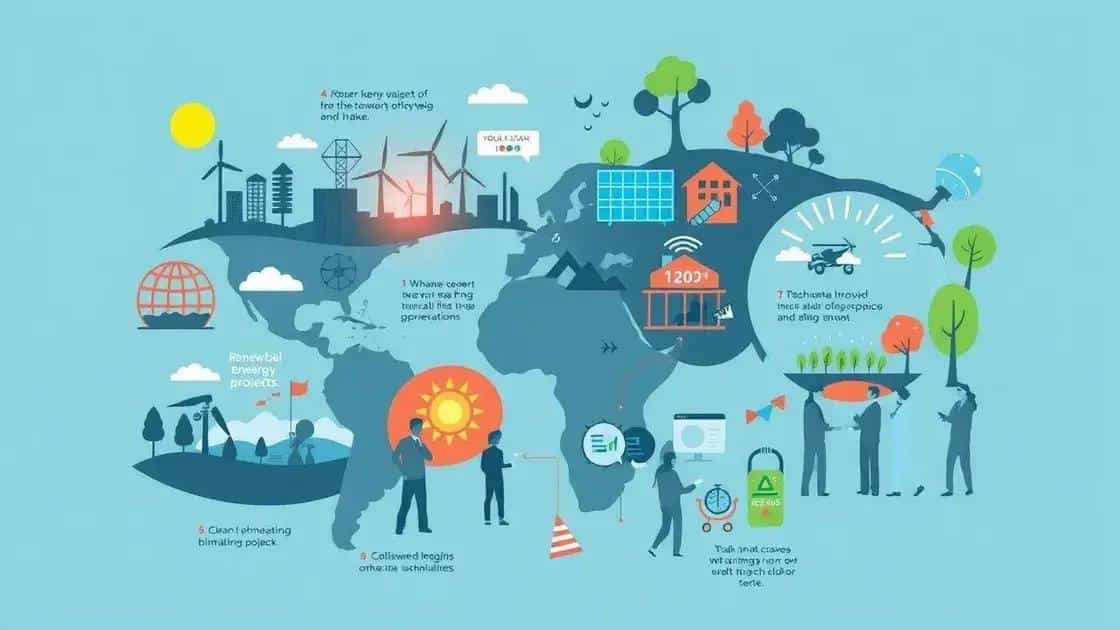Climate tech developments trends shaping our future

Climate tech developments are vital for reducing greenhouse gas emissions and promoting sustainability through innovations like renewable energy, efficient technologies, and supportive government policies.
Climate tech developments trends are rapidly changing the landscape of environmental solutions. Have you noticed how these advancements might influence your daily life? Let’s explore what’s happening in this vital sector.
Emerging technologies in climate tech
Emerging technologies in climate tech are leading the way toward a more sustainable and eco-friendly future. These innovations play a crucial role in combating climate change and promoting a healthier planet. Let’s explore some of the most exciting developments and how they can impact our lives.
Key Innovations in Climate Tech
Numerous technological advancements are reshaping the climate landscape. These innovations include:
- Carbon capture and storage (CCS): This technology captures carbon dioxide emissions from industrial processes and stores them underground to reduce air pollution.
- Smart grids: These systems enhance energy efficiency by integrating renewable energy sources and optimizing energy distribution.
- Sustainable agriculture technologies: Innovations such as precision farming and vertical farming help reduce waste and improve food production.
In addition to these key areas, we see advancements in materials science, such as the development of biodegradable plastics. With emerging technologies, companies are working to minimize the environmental impact of products and processes.
The Role of Artificial Intelligence
One of the most promising areas in climate tech is the use of artificial intelligence (AI). AI can analyze vast amounts of data to forecast weather patterns and resource needs. This makes it easier to plan for renewable energy production and manage energy consumption more effectively.
Furthermore, AI-powered tools help identify energy inefficiencies in buildings, allowing for targeted improvements and lower energy costs. By harnessing technology, we take significant steps toward a more sustainable society.
As we continue to explore emerging technologies, it’s crucial to remember the need for collaboration among governments, businesses, and consumers. Only together can we accelerate the adoption of these innovations and ensure a greener future.
Impact of renewable energy innovations

The impact of renewable energy innovations is rapidly reshaping our world. These advancements are crucial for reducing greenhouse gas emissions and promoting sustainable practices. Let’s take a closer look at how they benefit the environment and society.
Benefits of Renewable Energy
Adopting renewable energy sources brings numerous advantages:
- Reduction of carbon emissions: By switching to clean energy, we can significantly lower our carbon footprint, helping to fight climate change.
- Job creation: The renewable energy sector is a growing industry, generating new job opportunities in various fields, including engineering, manufacturing, and maintenance.
- Energy independence: Using local renewable resources decreases reliance on imported fossil fuels, strengthening national energy security.
Additionally, renewable energy innovations, such as solar and wind technology, have made clean energy more accessible and affordable. As these technologies advance, they become increasingly viable alternatives to traditional energy sources.
Technological Advances in Renewable Energy
Recent advancements in technology have led to increased efficiency in renewable energy systems. For example, solar panels are now capable of converting more sunlight into electricity than ever before. Wind turbines have also evolved, harnessing energy even at lower wind speeds.
Innovations in energy storage technology, such as batteries, allow us to store excess energy generated during peak production times. This stored energy can then be used during periods of low production, making renewable energy more reliable.
Moreover, smart grid technology plays a vital role in integrating renewable sources into our energy systems. By improving energy distribution and management, we maximize the use of available resources. The future of energy lies in these innovative solutions, paving the way for a cleaner, more sustainable world.
Government policies driving climate tech
Government policies play a crucial role in driving climate tech innovations. These policies create a framework that encourages the development and adoption of sustainable technologies. By implementing the right policies, governments can help accelerate the transition to a greener economy.
Key Government Initiatives
Several initiatives have been established to promote climate tech. These include:
- Incentives for renewable energy: Governments often offer tax credits and subsidies for solar, wind, and other renewable energy projects.
- Regulations on emissions: Strict regulations aimed at reducing greenhouse gas emissions compel businesses to innovate and adopt cleaner technologies.
- Research and development funding: Public funding for research programs helps advance new climate technologies and supports startups in this sector.
In addition to these initiatives, collaboration between the public and private sectors is essential. Governments are increasingly partnering with businesses to develop innovative solutions for climate challenges. This can lead to technological breakthroughs that might not occur in isolation.
International Climate Agreements
International agreements, such as the Paris Agreement, also play a significant role in guiding government actions. These agreements set ambitious targets for emissions reductions, which countries must meet. By committing to these targets, governments create urgency for adopting climate tech.
Moreover, participation in global climate initiatives fosters knowledge sharing among countries. This collaboration facilitates the exchange of best practices and technologies, driving further advancements.
As governments around the world take action to address climate change, it becomes increasingly clear that effective climate tech policies can lead to a more sustainable future. By prioritizing innovation and collaboration, we move closer to achieving our climate goals.
Challenges and opportunities in climate tech

Challenges and opportunities in climate tech are constantly evolving as technology advances. Understanding these aspects is crucial for stakeholders looking to make an impact on sustainability.
Identifying Key Challenges
Despite the progress in climate tech, significant challenges remain. Some of these include:
- High initial costs: Many renewable technologies require heavy upfront investments, which can deter businesses from adopting them.
- Regulatory hurdles: Complex regulations can slow down innovation and complicate the implementation of new technologies.
- Market competition: With many companies entering the climate tech space, standing out and ensuring product differentiation becomes difficult.
Addressing these challenges is essential for fostering an environment conducive to innovation. Solutions often involve collaboration among governments, private sectors, and research institutions.
Capitalizing on Opportunities
On the flip side, there are numerous opportunities in the climate tech sector. As awareness of climate change grows, so does the call for sustainable solutions. This creates business prospects in various areas:
- Investment in clean energy: With a global shift towards renewable sources, investors are increasingly focusing on companies that prioritize sustainability.
- Innovative technology development: Startups and established businesses alike are investing in new technologies that offer cleaner and more efficient ways to meet energy demands.
- Public interest and support: Growing consumer awareness and demand for eco-friendly products can lead to greater market opportunities for companies in the climate tech space.
As companies navigate the landscape of climate tech, finding the right balance between overcoming challenges and leveraging opportunities will be key to success in this rapidly changing environment. With effective strategies and collaboration, businesses can contribute significantly to a sustainable future.
In conclusion, the journey toward embracing climate tech presents both challenges and opportunities. By addressing issues like high costs and complex regulations, we can harness the potential of innovative renewable energy solutions. As we continue to push for more sustainable practices, collaboration among governments, businesses, and researchers will be critical in driving progress. With growing public interest and investment in clean technologies, the future looks promising for a healthier planet.
\n\n
\n
FAQ – Frequently Asked Questions about Climate Tech
What are the main challenges in adopting climate tech?
The main challenges include high initial costs, regulatory hurdles, and market competition that may hinder progress.
How can governments support climate tech innovations?
Governments can offer incentives, streamline regulations, and fund research and development to promote climate tech solutions.
What opportunities exist within the climate tech sector?
Opportunities include investments in clean energy, technological innovations, and growing public demand for sustainable products.
How does collaboration impact the success of climate tech?
Collaboration among governments, businesses, and research institutions can drive innovation and accelerate the transition to sustainable solutions.





